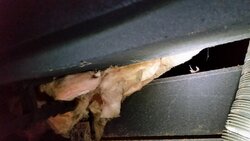Question -- this is my second winter in our home. I have noticed and can feel considerable drafts coming from the chimney and through the pellet stove insert sides, bottom, etc. I pulled out the pellet stove to take a look in the fire box and noticed that the prior homeowner attempted to insulate the chimney/flue opening but didn't do a very good job. I want to make sure this is something that i CAN do and is not a fire hazard etc. with the pellet stove insert. I assume it shouldn't be as the vent pipe is for intake and shouldn't get hot etc.
I'm new to all this and want to first resolve the incredibly cold drafts coming through the pellet stove insert putting extra work on our geothermal heat. I attached a picture of what the vent pipe and chimney insulation currently looks like. Obviously there are huge gabs and all the cold air is pouring in...
What's the best way to seal this? Any type of insulation work?

I'm new to all this and want to first resolve the incredibly cold drafts coming through the pellet stove insert putting extra work on our geothermal heat. I attached a picture of what the vent pipe and chimney insulation currently looks like. Obviously there are huge gabs and all the cold air is pouring in...
What's the best way to seal this? Any type of insulation work?


